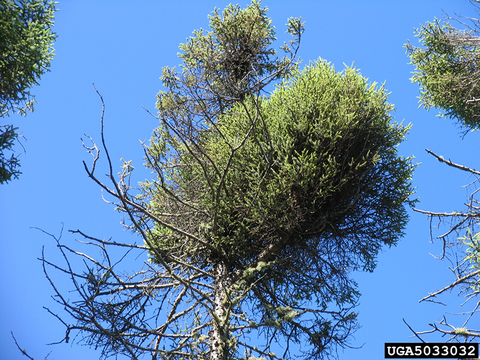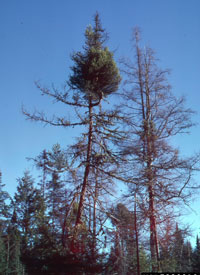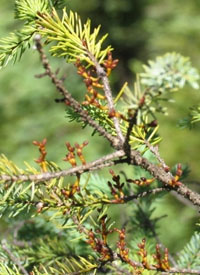Quick facts
- Dwarf mistletoe is a parasitic plant.
- It most commonly attacks black spruce in northern Minnesota.
- Dense clumps of branches called witches’ brooms form in infected trees.
- Needles turn yellow and fall off, from the top of the tree down.
- Prune out witches’ brooms.
- Remove infected trees with more than 50% dead branches.
How to identify dwarf mistletoe
Witches' brooms form on infected trees. These are clumps of small, weak branches arising from one point on a larger branch.
Needles within the witches' broom remain green. Needles on the rest of the tree turn yellow and fall off, typically from the top of the tree down.
Short (1/2 to 1 inch), brown to orange, dwarf mistletoe stalks can be seen during the growing season. They fall off after seed dispersal in August or September. These stalks form only after four to five years of infection.
Trees commonly affected by dwarf mistletoe in Minnesota
Dwarf mistletoe is a parasitic plant (Arceuthobium pusillum) that most commonly attacks black spruce (Picea mariana) in northern Minnesota, although white spruce (Picea glauca) are also highly susceptible to the parasite.
Dwarf mistletoe can also attack white pine, red pine, jack pine, eastern larch, balsam fir and Colorado blue spruce. These trees are typically only infected with dwarf mistletoe when planted close to groups of spruce infected with the parasite.
How does dwarf mistletoe survive and spread?
Dwarf mistletoe is a parasitic plant that lives its entire life within the canopy of the tree.
- Female flowers shoot seeds, coated in a sticky layer, up to 55 feet away.
- Seeds can also stick to birds or other wildlife and be carried to trees much farther away.
- If these seeds land on a spruce branch, they germinate and colonize their new host.
- Root-like structures grow into the tree branches and rob the tree of nutrients and water.
- Witches' brooms develop on infected branches.
- As the infection continues, the dwarf mistletoe continues to steal nutrients and the spruce tree begins to decline.
- After 4 to 5 years, the first dwarf mistletoe shoots appear on the infected spruce branches. These short (less than 1 inch) branches are yellow-orange and have only small, scale-like leaves.
How to manage dwarf mistletoe
Witches' brooms can be pruned out to improve the look of the tree and reduce the spread of dwarf mistletoe. The dwarf mistletoe may reappear in other parts of the tree within two to three years from deep root-like structures or new infections.
Trees infected with dwarf mistletoe with over 50% dead branches should be removed.
Do not plant spruce or other susceptible conifers near infected trees.
Reviewed in 2024




